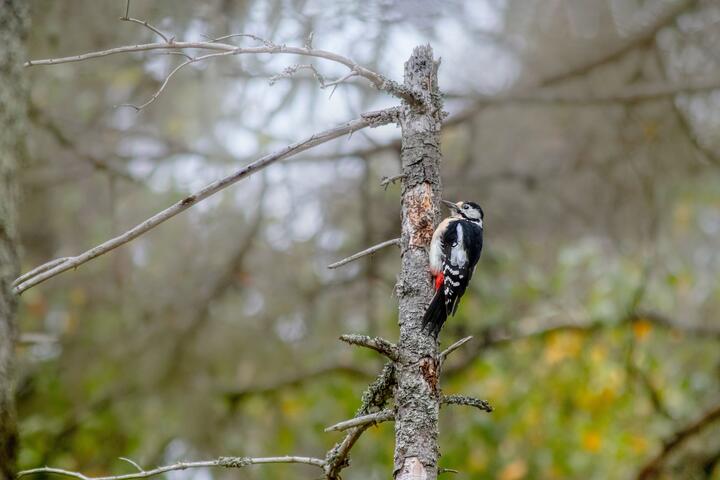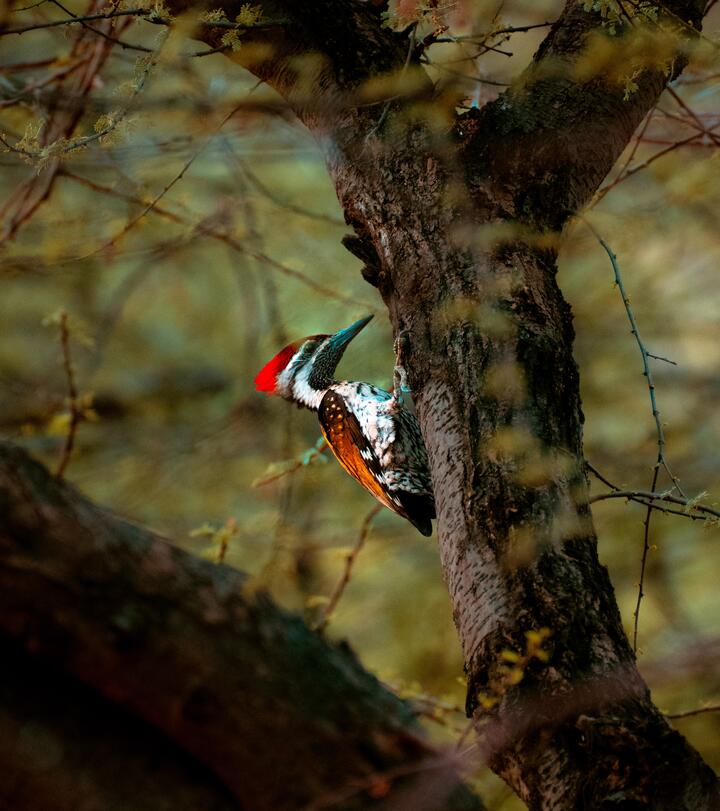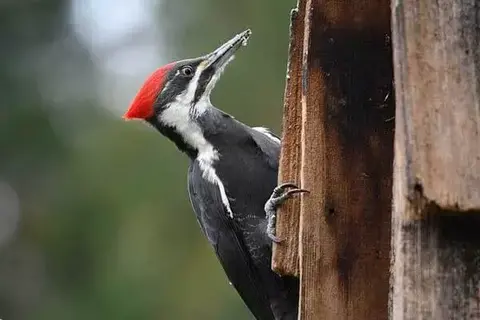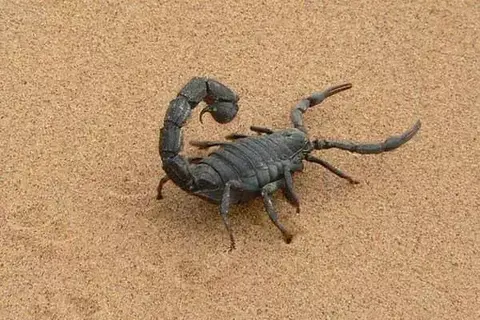Facts About Woodpeckers Pecking
Amelia BWoodpeckers (lat. Picidae) – a large family of birds, which includes 233 species.
 Photo by Erik Karits on pexels.
Photo by Erik Karits on pexels.In most cases, woodpeckers live in forests. These are climbing tree birds, which fly, although not very well. The vast majority of the family differ from other birds by an unusual chisel-shaped beak. With its help, woodpeckers chisel the bark and the core of the tree, trying to find their main food: insects and their larvae.
The woodpeckers use their strong beak not only for food but also for making nests, which are usually arranged in the hollows of trees. Woodpeckers knock on wood and communication with each other. In spring, males of many woodpeckers drum their beaks through dry trees. Such trills have probably been heard by many readers. The woodpecker’s body is almost perfectly adapted to its way of life. Thanks to this, the woodpecker can withstand significant loads, which are deadly for many other living organisms.
Wood chipping is a very energy-consuming activity. To replenish energy reserves, woodpeckers have to eat all the time. For example, a black woodpecker can eat about a thousand ants or several hundred bark beet larvae in just one “meal”. The green woodpecker eats even more – in one day it eats about two thousand ants.
The woodpeckers are called forest attendants, and this is, in principle, true. A bird, eating a large number of pest larvae of trees or adult insects, prevents an uncontrolled increase in the pest population.
Loads that a woodpecker can withstand
The average speed of woodpecker strikes is 20-25 movements per second. The total number of woodpecker blows per day is 8000-12000. For a bird to be able to withstand the overloads associated with chiseling trees, its skull and skeleton must be unusually strong. If any other bird hit a tree with such a speed, then after a few blows it would die of overloads.
Measurements show that the overloads experienced by the woodpecker reach 1000 – 1200g. This is much more than the organisms of other animals, including humans, can withstand. We are not able to withstand overloads greater than 80-100g. The highest (short-term) car overload at which a human being managed to survive is 179.8 g. Parachutists when opening a parachute experience overloads up to 10 g. Pilots who perform aerobatics are overloaded up to 12 g.
The woodpecker’s beak is strong enough to chisel a tree and not to break or deform. The tip of the beak of most woodpeckers is similar to a chisel. Thanks to this, birds can “work” with the hardest types of wood. When chiseling is active, the temperature of the brain increases. So the woodpecker can’t chisel all the time, he has to take breaks to reset the temperature.
A woodpecker has not only a strong skull and beak. This bird is equipped with a “shock absorber” in the form of cerebrospinal fluid, which suppresses the vibration. The shock absorber system of a woodpecker also includes an elastic beak, a stringy and springy hyoid bone (hyoid), and a special spongy bone in the head. A hyoid is more cartilage than bone tissue. It is located not only in the throat but also enters the nasopharynx, wrapping the skull. Thus, the bird’s skull box is one of the most advanced natural shock absorbers.
It softens the impact of more than one factor, and their whole system. During the chiseling of the tree, the beak moves perpendicular to the surface on which the woodpecker hits. If the impact is not perpendicular, but a little at an angle, the shock absorber mechanism of the bird would not work, and it could just die. But here works a well-coordinated system of muscles, which allows the head and beak to move in a straight line. When the beak hits, the muscles that pull the woodpecker’s skull away from the point of impact will immediately work.
The eyes of the bird are also protected from impact. When hitting a tree, the third eyelid (flashing eardrum) is lowered on the woodpecker’s eye. It protects the eyeball from vibration, preventing retinal detachment.
Another unique feature of the woodpecker is its long tongue. In all birds, the tongue is attached to the back of the beak. But the woodpecker’s tongue comes out of the right nostril, dividing into two halves. These two halves cover the bird’s head and neck, coming out through an opening in the beak. After that, they join together. The woodpecker’s tongue takes the insect larvae out of the deep passages made in wood.
To place within the skull all these amortization devices, the woodpecker had to do with the size of the brain. In the process of evolution, it has decreased. And the decrease in brain size did not lead to the woodpeckers becoming “stupider”. In fact, woodpeckers have a high organization of behavior. They have complex territorial and nesting habits.
But in birds, the “intellect” is the responsibility of striped calves and a layer called Hyperpallium. These parts of the brain are small in size, so the woodpecker can handle a relatively small brain.
Well, to move easily through tree trunks, woodpeckers use an X-shaped foot design. Two fingers on the woodpecker’s foot point forward and two fingers backward. Most birds of other species have three fingers facing forward and one finger facing backward. Stringent claws, strong bones of the fingers, and tendons help to hold the bark. All this provides a secure grip on the tree, and the woodpecker does not fall even during the most active “work”.
Facts About Woodpeckers’ Pecking Habit
 Photo by Arnav on pexels
Photo by Arnav on pexelsDid you know that woodpeckers are not dangerous to humans? It turns out that they don’t even injure themselves, and the damage they do is harmless to humans. They don’t damage their brains or necks, and they are perfectly happy to drill trees all day long. If you think woodpeckers are dangerous, read on to learn more about the pricking habit of these birds.
Although woodpeckers are not known for their vocal abilities, they use their pecking skills to construct their nest. The holes that they make in trees are used to structure the nest that they will eventually build. Usually, they make a number of small holes before they start building their nest. If they make larger holes, it is likely they are putting more effort into building their nest. When a woodpecker pecks multiple trees, it means they are trying to find food.
While woodpeckers do not make songs, they can make a variety of alarm calls. While most do not produce vocal sounds, the Gila Woodpecker has been recorded eating baby bird brains. Despite their aggressive behavior, the vast majority of woodpeckers do not attack people. In fact, they don’t attack humans in any way. But if they do, it could be a warning sign for them to leave your property.
Although woodpeckers do not have a vocal song, they do have large tongues. Using these tongues, they clean the wood and collect insects that are buried underneath its bark. They also build new holes in trees all year round and leave a trail of debris. This means that your house won’t be safe from woodpeckers anytime soon. So, if you have a bird that pecks at your window, you’ll have to be careful.
As we’ve seen, woodpeckers peck holes in tree trunks in order to feed on insects. Their large tongues extend over two inches past their bills and are used to clean the bark. Because they can’t sing, woodpeckers are not sociable. However, they do share the same habitat with hummingbirds. Acorn-peckers aren’t the only ones who peck.
In addition to pecking trees, woodpeckers also build nests. They use their large tongues to clean the wood. They also build nests to house other animals. When they’re building a nest, they will make multiple holes. This is how they build their nests. They will be able to dig new holes all year long. So, it’s no wonder that woodpeckers are the most prolific bird species in the United States.
The woodpecker is the only bird that uses its tongue to build a nest. They rely on their carving ability to create a nest. When woodpeckers are busy foraging, they’ll make small holes to build their nests. Then, they’ll start pecking again to make their nests larger. Those little holes are the foundations of their future homes.
Woodpeckers have a long tongue. This allows them to clean wood and remove pests. They are also very good builders. They will dig new holes all year round, and they’ll stay there until the next nesting season. You might even be surprised that they can build new holes all year round. It’s hard to imagine that they are able to do this. The reason for their prowess is that they’re constantly building new holes in the trees.
Woodpeckers create holes in trees by pecking insects. They also make a hole in the bark of the tree to store their catch. Since they’re not vocal birds, their pecking sound is very loud. This is because woodpeckers tap the trees with their wings to attract mates and scare predators. This is why they can hit a tree repeatedly. This is a very dangerous habit for a woodpecker.
Woodpeckers’ beaks are strong enough to chisel trees. The tip of the beak is similar to that of a chisel. This is one of the reasons that woodpeckers are able to “work” with even the hardest wood types. They also raise the temperature of the brain and can cause the bird to burn if they fall into a window.
- BirdsFacts About Woodpeckers Pecking

- InsectsInteresting Facts About ScorpionsBy Nolan Foster

- Wildlife20 Fun Facts About KoalasBy Noah Young

- Cats25 Interesting Facts About CatsBy Amelia B

- WildlifeAmazing Facts About Polar Bear CubsBy Evelyn Star

- BirdsCan Pelicans Fly?By Noah Young

- Livestock30 Interesting Facts About DucksBy Charlotte Green

- WildlifeHow Much Does Elephant Weigh At Birth?By Karla Miller

- WildlifeWhat Is The Koala Bear Diet?By Lucas Torres

- Rodents20 Interesting Facts About HamstersBy Noah Young
